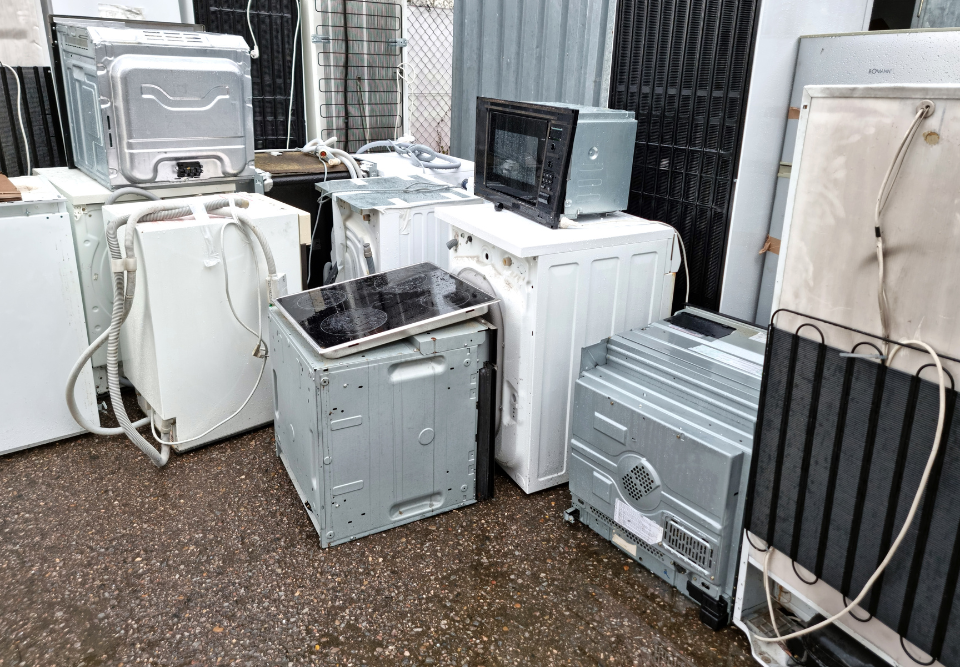
Top 5 Reasons You Need a Residential Junk Removal Service
August 8, 2025
How to Maximize the Life of Your Hot Tub Before Removal
August 11, 2025The Do’s and Don’ts of Appliance Removal
Prepare Your Space Before Removal
Creating a clear and accessible area around your appliances is essential. Begin by removing any obstacles, rugs, or furniture that might impede movement. This preparation not only ensures a safer passage but also reduces the risk of damage to walls, floors, or the appliance itself. Planning your pathway allows for smoother maneuvering, especially in tighter spaces. In addition, consider the surface on which the appliance will be moved; slippery or uneven floors can make even the lightest appliance cumbersome. Taking the time to strategize where the appliance will be temporarily stored or staged for removal can significantly reduce stress on moving day. Proper preparation reflects forethought and makes the overall process more efficient and less hazardous for everyone involved.
Equally important is understanding the appliance’s weight and balance. Heavy items like refrigerators or washing machines require more than just brute force; knowing the correct method to tilt, lift, or slide them prevents injuries. Using protective gear, such as gloves and closed-toe shoes, is another crucial precaution. When you take these steps seriously, the removal process becomes more predictable and manageable, minimizing surprises. The key is to approach the task with patience and methodical planning, which ultimately transforms a potentially chaotic job into an organized, safe undertaking.
Disconnect Utilities Properly
Before attempting to move any appliance, disconnecting utilities safely is a priority. Appliances connected to water, gas, or electricity pose significant hazards if handled improperly. Shut off the corresponding valves, unplug cords, and ensure the appliance is free from any attachments that could cause leaks or electrical shorts. Ignoring these steps can result in property damage, personal injury, or more complicated repairs later. Understanding the specific requirements for each appliance type is essential, as refrigerators, dryers, and stoves all have unique disconnection processes that cannot be approached interchangeably.
Proper disconnection also allows for safer transportation. An appliance still tethered to utilities can easily cause accidental spills, electrical shocks, or even gas leaks. Taking time to follow manufacturer instructions or consulting guides online can provide step-by-step clarity, ensuring nothing is overlooked. While it may feel tedious, these precautions prevent mishaps and reduce liability. By treating each appliance with respect for its mechanical and electrical components, the removal process maintains both safety and efficiency, allowing you to move appliances without unintended consequences or last-minute complications.

Use the Right Equipment
Using appropriate equipment can make a world of difference when removing large or heavy appliances. Dollies, straps, and moving blankets are indispensable tools that protect both the item and the people handling it. A sturdy dolly allows for controlled movement and reduces strain on your back, while straps can secure appliances to prevent tipping. Blankets or padding shield surfaces from scratches and dents, preserving the condition of both the appliance and your home. Without these tools, even a small misstep could lead to injuries or damage, turning a simple removal into a complicated problem.
Additionally, knowing how to utilize each piece of equipment is critical. Straps should be tightened without crushing the appliance, and dollies need to be positioned under the center of gravity to avoid tipping. Practice beforehand if necessary, especially with cumbersome appliances like freezers or washers. The right equipment paired with proper technique streamlines the process, making the job less physically demanding and safer. Investing in these tools is not only practical but also a safeguard against common mishaps that occur when improvising with household items alone.
Seek Help When Needed
Attempting to remove large appliances alone can be risky and inefficient. Seeking help from friends, family, or professionals ensures the task is completed safely and without unnecessary strain. Extra hands provide stability, especially when navigating stairs, narrow doorways, or uneven surfaces. Coordinated effort reduces the likelihood of dropping the appliance or causing injury. Even small appliances benefit from another person’s assistance to maintain control and prevent accidental bumps against walls or floors. Recognizing when help is needed reflects both common sense and respect for safety protocols.
Collaboration also brings an opportunity to share knowledge and problem-solving strategies. Experienced helpers may offer tips on lifting techniques, maneuvering tricky spaces, or even securing the appliance for transportation. Their presence adds confidence, alleviates stress, and often speeds up the removal process. By acknowledging the limitations of a single individual, you embrace a safer, more efficient approach. Enlisting help when necessary ensures appliances are moved responsibly, maintaining safety for everyone involved and protecting the integrity of the items and surroundings.
Dispose of Appliances Responsibly
Proper disposal is a critical step often overlooked in appliance removal. Appliances contain materials that can be harmful to the environment if not handled correctly. Instead of leaving items on the curb or dumping them improperly, research local recycling programs or donation centers. Some appliances may qualify for refurbishment or parts recovery, reducing waste and conserving resources. Being mindful of disposal options ensures that appliances are removed ethically and sustainably. Neglecting this responsibility can result in environmental damage, fines, or missed opportunities to benefit the community.
Recycling or donating appliances also contributes to broader sustainability efforts. Many local facilities accept working or repairable units, while nonfunctional items can be disassembled for parts and metals. Engaging professional junk removal services often simplifies this step, as they can guarantee appliances reach the proper destinations. Responsible disposal combines environmental consciousness with legal compliance, reflecting an awareness of the broader impact of your actions. By planning for ethical removal, you help protect the planet and ensure appliances are retired in a way that aligns with both safety and community standards.
Avoid Rushing the Process
Patience is key when removing appliances. Rushing through the steps increases the likelihood of mistakes, injuries, or damage to property. Allocating sufficient time for planning, preparation, and actual removal ensures that each task is handled correctly. Moving appliances too quickly can lead to collisions with walls, mismanaged lifting, or dropped items. Scheduling removal during a period of lower stress or fewer distractions enhances focus and control. Prioritizing a steady, methodical approach allows for a more seamless experience and reduces unnecessary tension.
Slowing down also permits careful assessment of each appliance’s condition before and after moving. Inspections can reveal hidden hazards, such as sharp edges or leaking fluids, that might otherwise be overlooked in a rush. Attending to these details minimizes surprises and allows for immediate corrective measures. A calm, deliberate pace fosters safety and reduces physical strain, ensuring appliances are removed efficiently while protecting both individuals and property. Avoiding haste transforms the task into a manageable process rather than a chaotic challenge.
Keep Safety Gear on Hand
Safety gear is not optional when moving appliances. Gloves, sturdy footwear, back supports, and even protective eyewear help prevent injuries during lifting and maneuvering. Gloves provide grip and shield hands from sharp edges, while appropriate shoes reduce the risk of slips or dropped items. Back supports offer additional protection for heavy lifting, and eyewear can prevent accidental injury from debris. Being proactive about safety ensures that minor mishaps do not escalate into serious incidents, creating a secure environment for everyone involved in the removal process.
Using safety gear also demonstrates a commitment to proper technique. Heavy lifting without protection places undue strain on muscles and joints, while appropriate equipment mitigates these risks. Preparing in advance with protective items ensures readiness for unexpected challenges. Even appliances that appear light can surprise movers with awkward shapes or sudden shifts. Equipping yourself correctly combines practicality with caution, creating a professional-minded approach to what can otherwise be a physically demanding task.
Understand Weight Limits
Every appliance has a weight limit that should not be underestimated. Recognizing the heaviness of each item allows for appropriate planning, including the use of lifting aids, helpers, or transport equipment. Ignoring weight considerations can result in muscle strains, equipment failure, or accidental drops. Estimating weight in advance also informs decisions regarding the number of movers required and the safest method for lifting and positioning. Respecting weight limits is a proactive way to prevent injuries and maintain control throughout the removal process.
Understanding the weight of appliances extends to transportation as well. Vehicles must be capable of handling the load without compromising safety or stability. Overloading a truck or dolly increases the chance of tipping or damage. By taking weight into account, you maintain both efficiency and security, ensuring that appliances are moved responsibly. Awareness of these physical parameters transforms a potentially dangerous task into a structured and predictable process that protects both movers and property.
Avoid DIY Hazards
Attempting to remove appliances without proper knowledge or tools can create unnecessary risks. DIY removal often overlooks important safety precautions or handling techniques, leading to injuries, property damage, or compromised appliance integrity. Certain appliances may contain hazardous components, such as refrigerants or electrical wiring, which require specialized care. Mismanagement of these elements can result in environmental or personal hazards. Recognizing the limits of DIY removal allows you to avoid preventable complications and maintain a secure process.
Even small missteps in DIY removal can have long-term consequences. Slips, drops, or improper lifting techniques may not only injure the individual but also render an appliance unusable. Professional services or experienced movers often anticipate these challenges and provide the right tools and expertise. By avoiding DIY shortcuts, the removal process becomes safer, more efficient, and less stressful. Accepting that some tasks benefit from professional attention is a practical mindset that ensures safety, compliance, and successful outcomes for every appliance removal endeavor.
Plan for Recycling or Donation
Considering recycling or donation options before removing appliances ensures responsible disposal. Working with local organizations or facilities allows you to give appliances a second life, whether through refurbishment, parts recovery, or charitable distribution. Planning ahead reduces last-minute decisions and maximizes the potential environmental and community benefits. This foresight also prevents appliances from ending up in landfills unnecessarily. Taking the time to explore recycling or donation channels demonstrates thoughtfulness and environmental awareness, which is increasingly important in today’s conscious society.
Proactive planning for recycling or donation also streamlines the actual removal process. Knowing the final destination of each appliance minimizes delays and confusion, creating a smoother workflow. Professionals in the field often have established connections with recycling centers or charities, simplifying logistics and ensuring compliance with local regulations. By integrating recycling or donation considerations into the planning stage, the removal process becomes environmentally responsible and socially beneficial, turning a simple task into a meaningful contribution to the community.
Conclusion
Appliance removal can feel daunting without proper guidance and planning. The key is to approach each step with safety, foresight, and respect for both the appliance and your surroundings. From preparation and disconnection to responsible disposal, every choice impacts the efficiency and safety of the process. Utilizing the right tools, seeking assistance, and understanding the physical demands of each item minimizes risk and ensures a smooth experience. Thoughtful planning prevents accidents, damage, and unnecessary stress, creating a process that feels manageable and even empowering.
For residents in Santa Rosa, CA, North Bay Junk Removal offers expert guidance and practical support for all junk removal needs. Their team is equipped to handle appliances safely and responsibly, ensuring each item is removed efficiently and disposed of in compliance with environmental standards. Whether you are updating your home or clearing out space, their services provide peace of mind and professional reliability. Contact North Bay Junk Removal at 707-478-6817 to schedule a pickup or consultation, and experience a seamless approach to appliance and junk removal that prioritizes safety, efficiency, and environmental responsibility.




